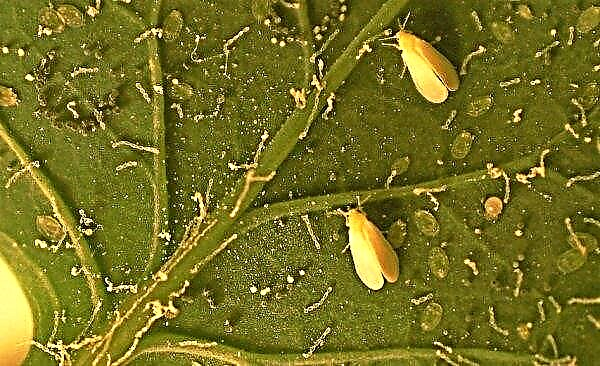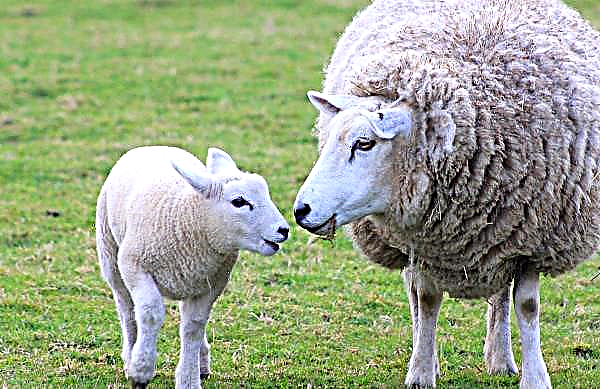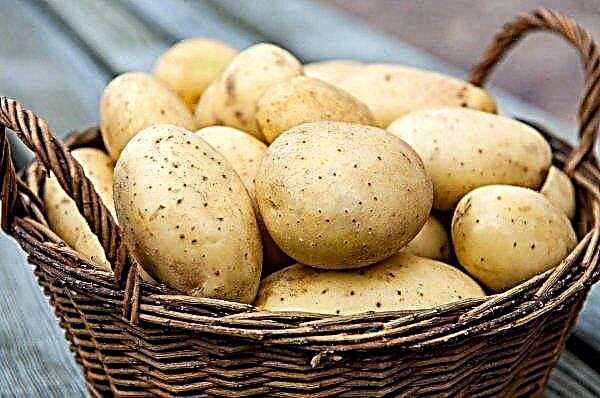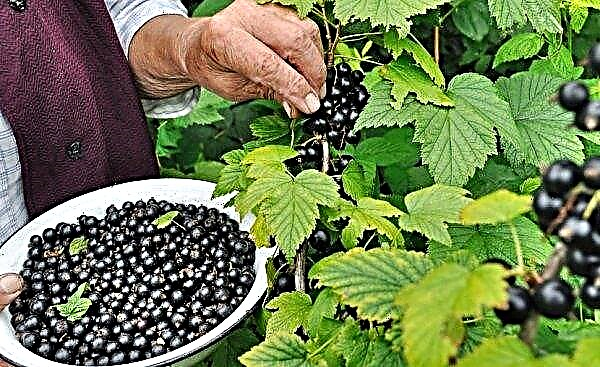Many gardeners love eggplant, but not everyone decides to grow a vegetable on their site. It is believed that this plant is quite whimsical, so care for it will require not only certain knowledge, but also skills. One of such requirements is the timely formation, without it the bush will not be able to form large fruits, as well as nourish them with all kinds of useful substances. This article discusses a detailed description of the main crop trimming methods, as well as their main features.
Eggplant Care General
Eggplant is an annual herbaceous plant from the Solanaceae family. This species is considered one of the most sought-after representatives of fruit crops; therefore, it is grown everywhere. In the southern zone, this plant is cultivated in open soil, while in a temperate climate it is grown in a greenhouse.
This is often associated with increased heat lovingness of the bush, the optimum temperature for its growth is in the range +25 ... + 30 ° C, which is achieved in a temperate climatic zone only under artificial conditions. The bush is also demanding for watering, eggplants develop best with moderate irrigation. In this case, the soil moisture should be constant, water is added regularly, in small portions. At the same time, sudden changes in moisture in the soil for the crop are quite disastrous.
To achieve a high yield of plants, they need to pay a lot of attention, after planting seedlings, it is necessary, at least 1 time per week, to weed and loosen the soil to a depth of 5–7 cm. This will protect the plants from exposure to weeds, as well as oxygen deficiency. Also, the soil needs timely fertilizer. Spend it at least 3 times: 2 weeks after seed germination, 14–20 days after transplanting seedlings into open soil and during active flowering.
During crop care, special attention should be paid to pruning. Despite the neglect of the procedure by many gardeners, only timely pruning helps to maximize the biological potential of each plant. This is explained by the fact that the removal of excess parts of the bush optimizes the development of the rest, in which case the pruning of infertile branches has a positive effect on the development of the crop. Therefore, they perform the formation shortly after transplanting seedlings into the soil and further throughout the growing season.
Did you know? Despite its nutritional value, eggplant is considered a rather dangerous vegetable. The fruit contains the harmful toxin solanin, so they are allowed to be used in food only in the phase of technical ripeness (the pulp and peel are dense, juicy and elastic).
Preparing an eggplant greenhouse
Eggplants require careful preparation of the greenhouse long before planting. The plant needs a special microclimate, and also does not tolerate sudden changes in temperature and humidity, so the greenhouse must meet all the requirements of the culture. In addition, painstaking preparation of beds can reduce to almost zero the chances of developing dangerous infections among the plantings.
They begin preparations with an inspection of the entire structure, during the development of plants any construction and maintenance work is extremely undesirable, therefore, repairs are carried out several weeks before planting. Not only load-bearing elements are subject to inspection, but also wall and ceiling panels, they must be airtight. Therefore, all the faulty parts are changed, and the cracks are filled with all kinds of sealants.
Next, the greenhouse is eliminated from plant debris and debris, after which weeding is carried out for 20-30 cm. The cleaned and plowed soil is sterilized, this measure is mandatory. Crop rotation is often impossible in the greenhouse, so over time the soil is saturated with pathogens of various infections, planting seedlings in such a substrate will threaten death for it, so the soil must be decontaminated. Sterilize the soil in many ways, but most often this is done by abundant watering or spray irrigation with disinfectants.
Sterilize the soil in many ways, but most often this is done by abundant watering or spray irrigation with disinfectants.
Most often used for this:
- potassium permanganate solution (1%);
- Mixture "Fitosporin" (5 g / 10 l);
- boiling water.
After this, the soil is left alone for 1-2 weeks, during which time the internal and external walls, as well as the roof, are cleaned. The outer surface is cleaned with water or a weak solution of laundry soap (5 g / l). If outbreaks of fungal and bacterial diseases were observed in the greenhouse last season, complex antimicrobials (Fitosporin, Trichodermin, etc.) are added to the liquid. The inner surface of the structure is cleaned with a 3% solution of copper sulfate, 10% bleach or boiling water of your choice. Upon completion of cleaning, all surfaces are washed with clean water and wiped dry.
Important! Once every 2-3 years in the greenhouse, it is necessary to completely replace the topsoil (25-30 cm) with a new one, otherwise the plant yield will be low.
Methods for forming an eggplant bush
Several methods are known for the formation of eggplant crowns, these are the so-called trimming techniques in one, two, three stems or more. This approach makes it possible to form an elegant crown, depending on the physiological characteristics of each individual variety, as well as to achieve rapid ripening of the crop. In this case, the procedure should be approached with caution, it is necessary to assess the state of the plantings, since radical pruning for weak plants always leads to their death.
In one stalk
Pruning a bush to a single stem is considered the most radical way of eggplant formation, but often this is a necessary measure.
In most cases, the following causes lead to this:
- weakened plants due to poor rooting or adverse conditions of detention. In this case, it is possible to direct all forces to the formation of fruits, which often does not occur without pruning;
- thickening of landings - one stem helps prevent a shortage of free space on the site, which is especially important for tall varieties;
- lack of lighting - in this case, pruning helps the fruits ripen qualitatively during the active vegetation, as well as to avoid shading of neighboring plants, which is always fraught with inhibition of growth of both.
The formation of a single stem on the bush begin two weeks after transplanting eggplant seedlings to a permanent place. If the plant is weakened, it is permissible to carry out the first pruning with a delay of up to 1 week. Regardless of the moment of the first formation, the procedure is subsequently repeated with an interval of 2-3 weeks, up to the technical ripeness of the fruit.
The formation of an eggplant bush to one stalk provides for the following measures:
- In the root zone of the stem, up to 5 leaves remove all lateral shoots and ovaries.
- In the zone of 6-8 leaves, half of the ovaries are cut off and pinch all stepsons.
- On about 10 leaf pinch all the shoots after the first leaf with ovary.
- After 10 leaves on the stem leave shoots with ovary on two leaves, while at the top it is allowed to store no more than 3 leaves.
In two stems
The formation of two stems involves the creation of an elongated stem, at the top of which a crown with fruits will develop. As in the previous version, depending on the state of the plants, this procedure begins 14–21 days after the seedlings are planted in open soil.
Such trimming is carried out as follows:Important! During the pruning of the bush, it is necessary to pay attention to its shadow, it should not shade leaves, shoots and the future ovary, as well as neighboring plants.
- After the plant reaches 35 cm, pinch the top, it activates additional buds and contributes to the growth of lateral shoots.
- After 1-2 weeks, all lateral branches are cut off on the bush, leaving only the 2 most viable. At the same time, any lateral shoots developing below 2 lateral ones are also subject to removal. It is allowed to leave 2-3 lower leaves shading the trunk ring of the soil, this will protect the substrate from excessive evaporation of moisture.
- In the future, pruning is carried out every 2-3 weeks, any additional lateral processes are subject to pruning, as well as extra leaves, shoots developing on 2 lateral stepsons. As the ovary appears, it is thinned, while their number must be gradually increased from the bottom to the top.
Video: Two-stem eggplant
Three stems (or more)
Trimming to three stems is considered the most popular. In addition to the fact that it makes it possible to form a dense crown, only in this case can a high yield of plants be achieved. However, it is not always useful, they are used only in the case of free planting of eggplant, as well as to fill the free space of the greenhouse, with thickened plantings, it will lead to inhibition of eggplant.
This formation will be brought about by the following successive steps:- After the seedlings are extended to 30–35 cm, pinch the top.
- After 1-3 weeks, all side shoots are removed on the bush, leaving only the 2 most viable.
- After another 2 weeks, they begin to form additional shoots. To do this, on each of the main leaves 1 stepson, which pinch after 2 leaves, the ovaries are not removed. Shoots without ovaries, as well as excess foliage, are also subject to removal.
- About 30 days before the expected harvest date on the bushes, pinch all the growth points, this contributes to a more active growth and ripening of fruits.
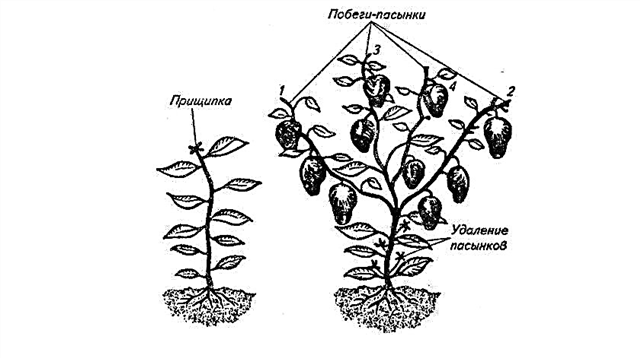
Subsequent eggplant care
Caring for trimmed plants is no less important than the formation procedure itself. The duration of the stress phase after the procedure only depends on this. In addition, careful and painstaking care will help prepare eggplants for future flowering and effective fruit formation.
Watering
Providing eggplant with optimal soil conditions will help regular watering. As a result of this, it is possible to improve the quality and quantity of the crop. The beds are irrigated at least once every 2-3 days, and during the summer drought, the irrigation rate is doubled. To do this, it is recommended to use water preheated to ambient temperature or at least + 20 ° C.
Use only clean and well-maintained water for this; when cultivating a vegetable in favorable environmental conditions, irrigation can also be carried out with rainwater. Depending on the size of the plants, 2 to 5 liters of water are applied under one bush. The day after watering, the soil must be loosened to a depth of 5-7 cm, which will help to avoid air deficiency in the substrate.
Top dressing
Top dressing is one of the main conditions for a high yield, therefore, it is carried out quite often. The first time the procedure is carried out 14-20 days after transplanting seedlings. Earlier feeding is not only ineffective, but can also cause burns to the root system. Further recharge is carried out at the discretion of the vegetable grower, the main thing is to do them with a frequency of several weeks. At the same time, 3–5 substrate feedings are considered to be the minimum that will ensure high planting yields and fruit quality.
Before ovaries appear, the beds are fertilized with any complex mineral fertilizer for fruit crops based on phosphorus, potassium and nitrogen. Fertilizers are used in liquid form, according to the manufacturer's recommendations. During the fruiting period, nitrogen-phosphate solutions are considered most suitable. To prepare them in 10 liters of water, dissolve 1 tsp. saltpeter and 1 part superphosphate. The resulting mixture is used on 1.5–2 m² of plantings for abundant watering of the soil.
Important! Eggplant must be fed before flowering, this will not only speed up the process, but also stimulate the appearance of ovaries.
Optimal conditions
Eggplants do not like high humidity, therefore, as they are grown, it is necessary to adjust the indicator to 60–70%. To do this, airing is carried out in the greenhouse, while drafts are forbidden to plants. They provoke sharp changes in temperature, which causes the falling of the ovaries and hypothermia of the bushes.
Also, the vegetable is demanding on heat. Despite the fact that it is able to withstand temperature drops of up to + 12 ° С, when the indicator decreases to + 20 ° С, the metabolism is inhibited in eggplant. At the same time, not only growth is inhibited, but also flowering, as well as the formation of the ovary, which leads to an almost complete loss of the ability to bear fruit. Therefore, the optimum temperature of growing the culture is considered the optimum at +25 ... + 30 ° С.

Common formation errors
The most common mistakes of vegetable growers during the formation of bushes:
- rejection of the formation: this leads to the development of ineffective shoots and excess leaves, as a result of which the bush spends all its strength not on pouring fruit, but on maintaining green mass. This dramatically affects the activity of fruiting eggplant and ripening fruits. Therefore, eggplant trimming should be carried out necessarily, the exception is only low-growing early ripening varieties;
- rejection of pinching stepsons (since this inhibits the growth of the bush): indeed, trimming stepchildren causes stress in the bush, however, without this, the filling of the fruits is difficult or may even stop at all. Stepsons are removed even in the first pruning, while you need to regularly monitor the appearance of new unwanted branches;
- neglect of pruning leaves and side shoots on the lower part of the bush when 2 or more stems are formed: as a result of this, excessive shading of the soil is observed, which provokes a slow evaporation of moisture. Often this creates a favorable environment for the development of putrefactive infections or wilting of the root system. Parosle below the main side shoots is necessarily removed, with the exception of 1-2 basal leaves, which protect the soil from drying out. Do this as early as possible, during 1-2 formation;
Did you know? Eggplant is considered one of the oldest fruit crops. The plant first began to grow another 1.5 thousand years ago, in the modern Middle East, southern Asia and India.
- on top sharply reduce the number of ovaries: Often this is considered a requirement, since nutrients hardly reach the upper zone of the bush. However, this statement is false, since it is at the top that the largest and highest-quality fruits develop. A timely assessment of the condition of the forming bushes and the number of ovaries on them will help to avoid this;
- untimely pinching of the bush: This error leads to excessive stretching of the plant, which threatens the stem with deformations and damage. In addition, often this leads to a deterioration in the growth of fruits. To avoid this, after the bush has reached the average size of the variety, pinch the top and all growth points.
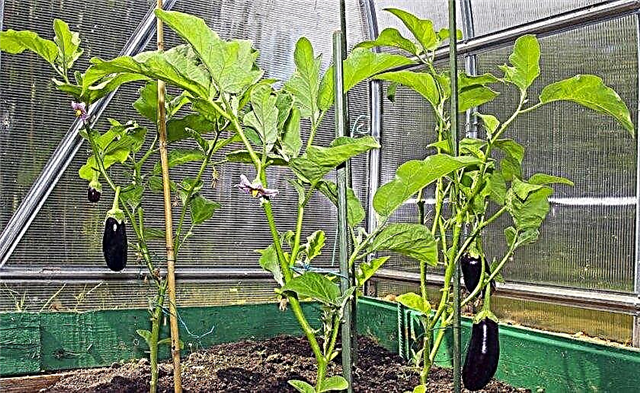
Tips from experienced gardeners
Due to the existence of many auxiliary methods, growing eggplants today is becoming a simple task for many, however, in reality, not many manage to grow quality fruits.
To reduce the possible risks of plantation death, as well as reducing their yield during cultivation, you must always adhere to the following recommendations:
- Before planting seedlings, you should thoroughly study the basics of agronomic cultivation of Solanaceae;
- the greenhouse must be prepared, and the soil in it is well fertilized, the crop hardly grows on poor substrates;
- the eggplants do not tolerate thickened plantings; they are planted with a row spacing of at least 50-60 cm, with bushes spaced in a row of about 50 cm;
- for 2 weeks after planting, the plants experience severe stress, in order to reduce the beds, they need to be loosened at least 4 times, and also well moisturized;
- a garter is a mandatory measure when growing a crop; without it, plants are seriously damaged and die even in the green-ripe phase of the fruit;
- no more than 15 fruits should develop on one plant, the remaining ovaries must be removed;
- if you take care of plantings no more than 1 time per week, give preference to early ripening zoned varieties, they are less demanding on the formation, watering and top dressing.
Eggplant is a rather demanding crop, for its successful cultivation not only the optimal microclimate in the greenhouse will be required, but also care. Correct formation plays one of the most important roles, the procedure helps not only to thin out crops, but also to optimize all the forces of the bush on the formation and filling of the fruits. Trimming eggplant is not difficult, however, you should take into account the characteristics of each bush so as not to aggravate the general condition of the plants.







